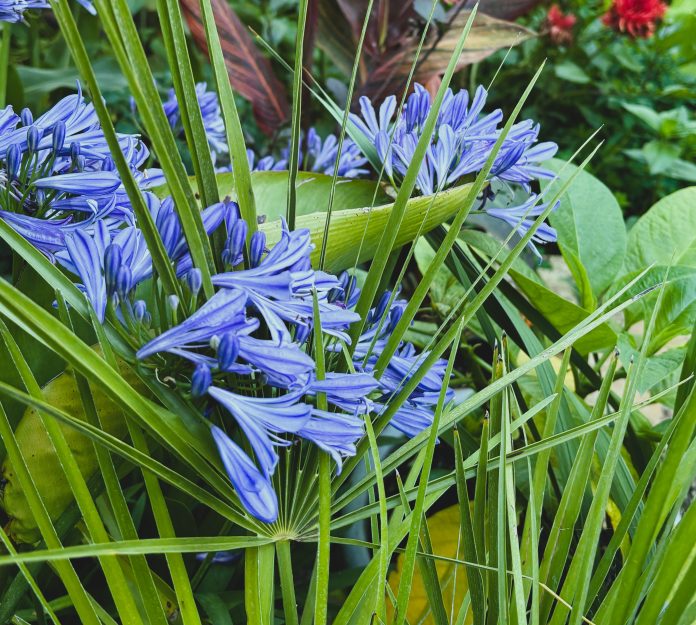Agapanthus, also known as African lily, is a striking plant renowned for its clusters of trumpet-shaped flowers held on tall stems. These elegant blooms, typically in shades of blue, purple, or white, add a touch of sophistication to UK gardens from midsummer through early autumn. Hardy varieties are perfect for borders, while tender ones thrive in pots.
Here’s how to grow and care for agapanthus in the UK.
Choosing the Right Agapanthus
Agapanthus comes in two main types:
- Deciduous Varieties: Better suited to UK gardens as they are more frost-hardy. Examples include Agapanthus ‘Headbourne Hybrids’ and Agapanthus campanulatus.
- Evergreen Varieties: Require winter protection. Popular choices include Agapanthus africanus (requires acid soil) and Agapanthus praecox.
Planting Agapanthus
- When to Plant
- Plant agapanthus in March to May, once the soil has warmed.
- Location
- Choose a sunny, sheltered spot; agapanthus thrives in full sun and needs protection from strong winds.
- They perform best in well-drained soil and can tolerate coastal conditions.
- Soil Requirements
- Agapanthus prefers fertile, well-draining soil. Apart from Agapanthus africanus, they are not fussy about soil ph.
- Improve heavy clay soils with grit or organic matter.
- How to Plant
- For borders, plant bulbs or rhizomes 8–10 cm deep and 30 cm apart.
- In pots, use a loam-based compost like John Innes No. 2 mixed with grit for drainage.
Caring for Agapanthus
- Watering
- Water regularly during the growing season (May to September) to keep the soil evenly moist but not waterlogged.
- Reduce watering once the plant becomes dormant in autumn.
- Feeding
- Feed with a balanced fertiliser in April to June to encourage flowering. Avoid high-nitrogen feeds, which promote foliage over blooms.
- Deadheading
- Remove faded flowers to encourage more blooms and prevent self-seeding.
- Winter Care
- Deciduous varieties can remain in the ground, but mulch heavily in November to protect the crowns.
- Evergreen varieties or potted plants should be moved to a frost-free location or wrapped in horticultural fleece.
- Pruning
- In February, cut back dead foliage on deciduous varieties to make way for fresh growth.
Seasonal Care Guide
- March to May: Plant new bulbs or divide established clumps. Water regularly as growth begins.
- June to August: Agapanthus is in full bloom. Water consistently and feed every two weeks with a tomato-based fertiliser.
- September to October: Reduce watering as flowering finishes. Collect seeds if desired.
- November to February: Protect evergreen varieties and mulch deciduous ones to prepare for winter.
Growing Agapanthus in Pots
Agapanthus thrives in pots, making it ideal for patios or smaller gardens:
- Choose a pot at least 30 cm wide with good drainage holes.
- Plant bulbs so their tops are just visible above the compost.
- Water sparingly in winter but increase watering in spring as growth resumes.
- Repot every 3–4 years in March if plants become root-bound.
Companion Planting
Agapanthus pairs beautifully with:
- Lavender and salvia: Their spiky, colourful flowers complement agapanthus blooms.
- Grasses like Stipa tenuissima: Add texture and movement alongside agapanthus.
- Summer perennials like echinacea and rudbeckia: Create a vibrant midsummer display.
Propagating Agapanthus
- Division
- Divide clumps in March to April, lifting the plant carefully and separating offsets with a sharp knife. Replant immediately.
- Seed Propagation
- Collect seeds in September. Sow them in pots of moist compost and keep them in a cool, frost-free location. Seedlings may take 2–3 years to flower.
Conclusion
Agapanthus brings bold architectural beauty to UK gardens, thriving in sunny spots with minimal care. Whether in borders or pots, its vibrant blooms and striking foliage make it a garden favourite. With the right care and winter protection, agapanthus will reward you with stunning flowers year after year.




